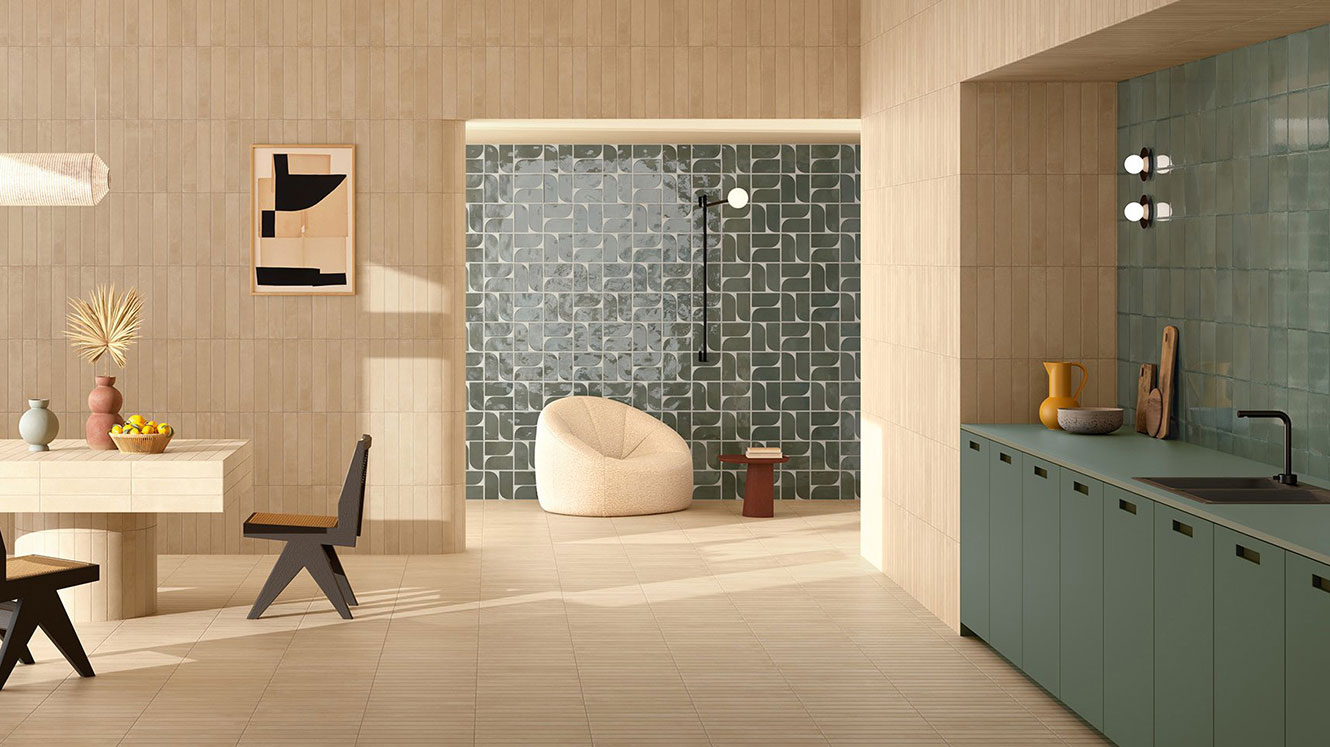Cover image: In the open-plan living room and kitchen, Del Conca tiles combine neutral tones and deep greens, enhancing brightness and adding a sophisticated graphic touch to walls and backdrops.
A practical guide on how to select the ideal color based on room size, lighting, and furnishing style.
Choosing the perfect color for a room is an exciting journey into the world of interior design. It’s a decision that goes beyond simple personal taste: color has the power to radically transform a space and deeply influence our mood and perception. In this guide, we will explore how to select the ideal color for each room, taking into account various aspects such as room size, lighting, and décor style.
When you start thinking about wall color, it’s important to consider the unique character of each room. Every space has its own personality and purpose: a bedroom should be a serene and relaxing retreat, while a living room might be designed to welcome family and guests with warmth and comfort. Color can help define and enhance these qualities, creating an atmosphere that reflects our lifestyle and preferences.

Evaluate natural and artificial light
One of the first steps is to assess the natural light entering the room. Large, bright windows can handle bolder and deeper colors, while rooms with less natural light can benefit from lighter shades that visually open up the space and make it feel brighter. The room’s orientation relative to the sun can affect color perception: north-facing rooms tend to receive cooler, softer light, while south-facing ones enjoy warmer, more direct light.
Match the color to the room size
Room size is another key factor to consider. Smaller rooms can appear larger and airier with light colors such as white, beige, or pastel tones, which reflect light and create a sense of openness. In contrast, larger rooms can benefit from more intense and darker shades like navy blue, deep green, or slate gray, which add warmth and definition without visually overwhelming the space.

Coordinate color with furnishings
Beyond light and size, it’s essential to consider the style of existing furnishings. The wall color should harmonize with the furniture, fabrics, and other decorative elements in the room. For example, if you have a dark gray sofa, you might choose a wall color that complements it, such as a light gray or neutral beige. This consistency helps create a well-balanced and cohesive environment.
Choose colors based on the desired atmosphere
Another important aspect is the atmosphere you want to create in the room. Colors have the power to evoke emotions and stimulate different sensations: light blue can promote calm and relaxation, olive green can enhance focus and productivity, while bright tones like yellow or orange can bring energy and vitality. By choosing color based on the mood you wish to convey, you can further elevate the overall experience of the space.
Test before deciding
Finally, before making a final decision on color, it’s advisable to test several options directly on the room’s walls. Purchase color samples or use removable paint to see how natural and artificial light affects different shades throughout the day. This gives you a clearer view of how the color behaves in real conditions and helps you make a more informed and confident decision.

Choosing the right color for a room is a process that requires time, reflection, and a bit of experimentation. Carefully consider light, room size, furnishing style, and the desired mood to find the perfect combination that will turn your room into a unique, welcoming space that perfectly suits your needs and lifestyle.
Explore our indoor tile collections on Tilelook: from elegant neutral surfaces to bold, modern colors, perfect for every room in the house.

